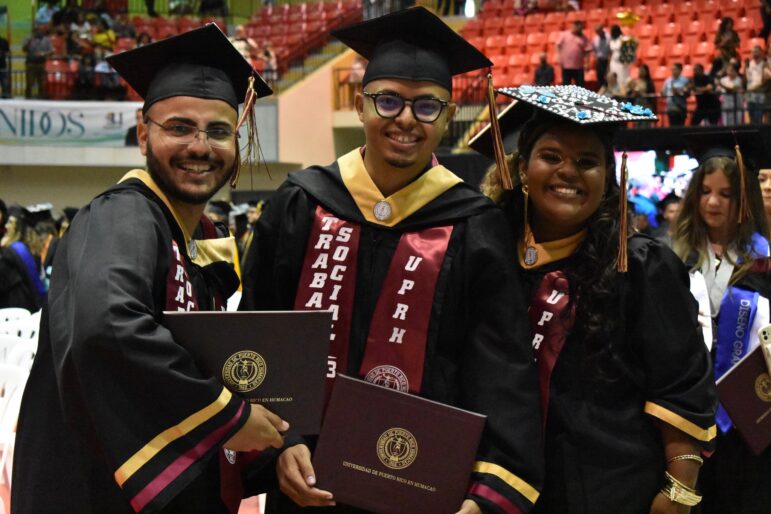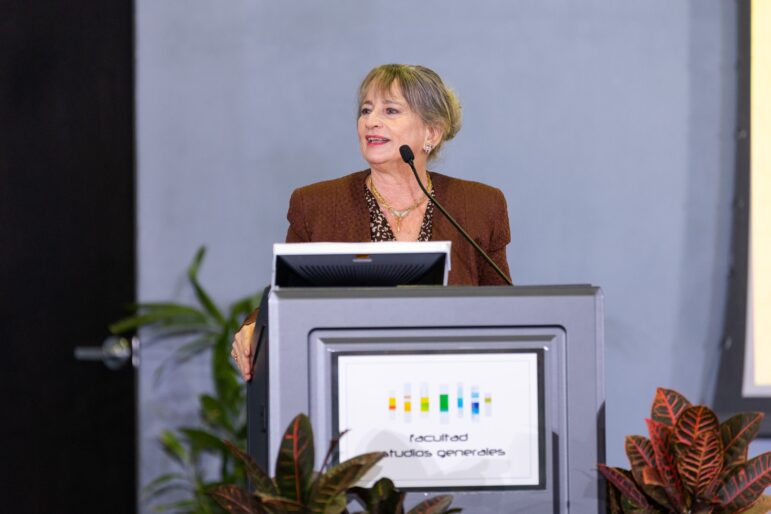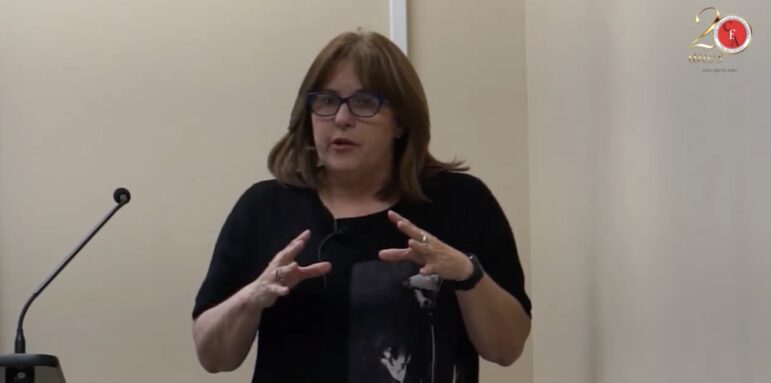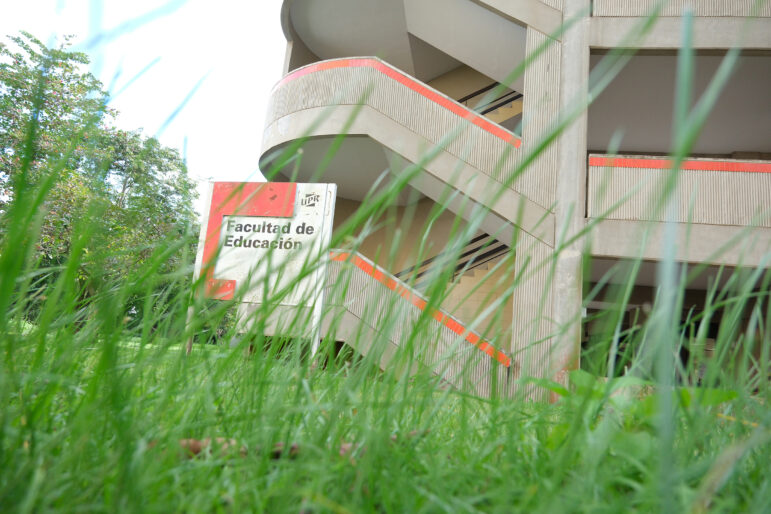The grass is so high at the Río Piedras Campus of the University of Puerto Rico (UPR), it can swallow people’s feet. When it’s mowed, one may stumble upon one of the many clumps of grass that are left lying on the ground after trimming is complete. The cracks and holes in the sidewalks of the campus, the leaks in classrooms and offices, as well as the mold in the buildings, come together to offer an unpleasant experience and may suggest that people don’t study at this university.
Despite the dismantling, which extends to its academic offer, as well as a dramatic decrease in its student body, the UPR system maintains its graduation rates above the numbers of most private nonprofit university institutions in Puerto Rico, as reflected in reports from the Integrated Postsecondary Education Data System (IPEDS). This is a system of surveys conducted annually by the U.S. Department of Education’s National Center for Education Statistics.
A look at these data from the 2010-11 academic year to the 2021-22 academic year shows that most of the 11 UPR campuses had an increase in their graduation rates in the context of the fiscal crisis, the pandemic, and budget cuts that keep the island’s main educational institution in check.
According to the IPEDS reports for the year 2022, all UPR units, except for Utuado and Bayamón, registered graduation rates higher than 45% for students who completed undergraduate studies in six years or less as of 2015; or in time and a half compared to what was planned by the institution to complete the cycle of studies. Humacao, Arecibo, Ponce, Cayey and Río Piedras exceeded 50%.
The UPR graduation rates of full-time students seeking to finish a bachelor’s degree showed that Humacao led, with a graduation rate of 50.6%, followed by Aguadilla (50.5%), Río Piedras (50.1 %), Carolina (48.4%), Cayey (47.2%), Mayagüez (47%), Ponce (45.7%), Arecibo (44.8%), Bayamón (38.6%) and Utuado (18.3%) for the 2021-22 academic year. The Medical Sciences Campus was not included in the report.

Courtesy photo | Facebook UPR-Humacao
These rates only reflect students who entered and graduated from those campuses. They do not include students who arrived at those campuses through transfers from other institutions outside the UPR system. But if you look at the transfer statistics, Bayamón and Utuado show high graduation rates for students transferred to their campuses (49.1% and 40.6%, respectively).
To calculate their rates, the report uses the duration of the academic programs. In the case of the bachelor’s degree, designed to be completed in four years, a standard estimate of six years is made, which is the term granted by the U.S. Department of Education to provide financial assistance. The report draws its data from a cohort study, which is when groups of students expected to graduate during a particular year are examined.
The data reported in IPEDS are submitted by the universities themselves. The U.S. Higher Education Act of 1965 establishes that every institution that receives federal funds for education scholarships under Title IV provides data on enrollment, graduates, graduation rates, teaching, costs, financial aid, among others.
UPR in the mirror of ‘competition’
Only the Barranquitas campus of Interamerican University showed a 55% graduation rate in the IPEDS report, higher than that of the campuses that make up the UPR system. The San Germán campus of Interamerican University also graduated a similar number of students to those of the public system, with a graduation rate of 46%.
However, six of Interamerican University’s nine campuses had graduation rates between 33% and 39%, and one of its campuses, Bayamón, had a graduation rate of 29%.
Meanwhile, the Ana G. Méndez University (UAGM), which together with the Interamerican University is one of the main nonprofit post-secondary institutions operating in Puerto Rico, only managed to graduate three out of every 10 students who enrolled.
None of its three campuses in Puerto Rico (Gurabo, Cupey and Carolina) reflected a graduation rate higher than 30% among students who completed their undergraduate studies in six years or less.
The UAGM did not reach even 5% in any of its campuses with the graduation rates corresponding to undergraduate students who completed studies in four years or less during the indicated period. In fact, with those students who completed their undergraduate studies in eight years or less, their graduation rates fell below 35% in all three units.
According to UAGM’s Vice President of Academic Affairs, Edgardo Rosaly Manfredi, the numbers from his institution respond to a combination of factors: the demographic challenges Puerto Rico faces in the context of the brain drain, the drop in births, the natural phenomena that have affected Puerto Rico, and an “institutional open-door policy,” based on “the philosophy that education is a right and not a privilege,” he explained.
Regarding the latter, Rosaly Manfredi said UAGM is an institution that is not governed by parameters that condition the admission of students to their academic records. Therefore, from his perspective, the risk of students not performing successfully increases. He referred to the case of the American University (AUPR), which announced that it will cease operations due to low enrollment.
The two campuses that made up that university (Manatí and Bayamón) registered graduation rates below 35% in the IPEDS reports for the year 2022. The rates were 32% and 26%, respectively, for students who completed undergraduate studies in six years or less from 2015, or in the time and a half compared to what was planned by the institution to complete the study cycle.
The evaluation of the vice president of Academic Affairs of UAGM establishes a direct relationship between the reduction of students and academic performance. But it contrasts with what emerges from the data from the UPR and from other private nonprofit institutions, which, despite facing similar or more serious challenges, show higher numbers.
According to the IPEDS report, the Pontifical Catholic University’s Ponce campus had a graduation rate of 42%. Atlantic University College had a graduation rate of 46% and Sacred Heart University of 41%.
The two sides of the coin
In August 2017, when the UPR received an annual government allocation of almost $900 million, undergraduate credits cost $56. Under the austerity policies of the Fiscal Control Board (JCF), the undergraduate credit increased to $157.
While tuition costs rose and the academic offer weakened, the institution hired Jorge Haddock in 2018, who presided over the UPR until his dismissal in 2021 for $240,000 a year. That salary represented more than double the annual salary cap for the position of president established in Certification 90 (1996-1997) of the defunct Board of Trustees.
While this was happening at the UPR, in 2020 the Gurabo campus of the Ana G. Méndez University, which registers the lowest graduation rate among the three units that make up UAGM (26%), announced it had gotten an allocation of $1.7 million. The funds came from a proposal under the federal Student Support Services program of the U.S. Department of Education to serve 283 eligible students annually for a period of five years.
The goal of this program “is to boost the retention and graduation of first-generation university students, with limited economic resources and individuals with functional diversity who have demonstrated academic need.” When the Vice President of Academic Affairs was asked how this initiative is going, without going into specific details, he again referred to the limitations caused by the drop in enrollment and the talent drain.
Currently, the UPR receives an annual allocation from the General Fund that barely reaches $500 million. Since 1966, through the University of Puerto Rico Funds Allocation Act, the Government established as a public policy the allocation of a percentage of the island’s general budget to the UPR, identifying it as an “essential element of its goal to broaden the university’s autonomy in its fiscal aspect and increase its resources” for the future. In 1993, for example, the UPR was supposed to receive up to 9.6% of the average government revenue of the two previous years, which no longer happens.
UPR graduates, but its crisis worsens
The School of Education at the UPR’s Río Piedras Campus, for example, lost 49% of its enrollment at the undergraduate level between August 2017 and August 2022. According to data from the Dean of Academic Affairs (DAA), that is the faculty that has lost the most students on that campus, since the JCF’s arrival, the devastation of Hurricane María and the pandemic. It also has the second lowest graduation rate campus-wide (25%), after Communications (21%).
The offer of classes or sections of the School of Education saw a 32% reduction of its sections at the undergraduate level when comparing the second semester of the 2017-2018 academic year and the second semester of the recently completed academic year. For the same period, a reduction of 18% of the sections, in general, was seen for the undergraduate level at the Río Piedras Campus.
This is the other side of the coin: a systematic dismantling that goes in the opposite direction to what the institution’s graduation rates reflect.
As part of the administrative adjustments, the opening or closing of courses depends on the capacity of the classroom and the capacity of the section. It also depends on the equipment available for the students in that classroom. Even if the enrolled students fit in the room and there is enough equipment, the section may be closed if there isn’t the minimum required enrollment for that section.
At the end of the first semester, the administration of the UPR announced that the courses had to have enough student demand to “be self-liquidating.” That is, they generate enough income to cover the salary of the professor assigned to the course.
“If a professor does not reach that minimum quota in their section, they close it and, so they may be left without the full load [12 credits or more per semester]. Then the professor must find what to do to replace those three credits, in case three are missing from the full load. And they must justify how they’re going to work that class time, either in administrative tasks or doing research. A complete improvisation. In other words, if you don’t have a project prepared, it’s like producing one out of nowhere just to comply,” said Julio Rodríguez, Professor at the School of Education of the Río Piedras Campus.
The data from the Central Administration, which exclude the Mayagüez Campus (UPRM), show that Río Piedras is the campus that has lost the most sections in the last five years. The institution did not provide UPRM data, which the CPI requested.
The other campuses have experienced progressive reductions comparable to Río Piedras. The one that was most affected in the period from 2017-2018 to 2021-2022 was Utuado, with a 44% drop in its undergraduate-level sections. That number is almost twice the drop in Río Piedras.
Several professors that the CPI consulted agreed that what usually happens in these cases that Rodríguez described is that sections are taken away from professors under contract, most of them with doctorates, so that those who are tenured have the 12 credits corresponding to the full load.
Rodríguez added that there are nine tenured professors in his department. There were 21 when he began teaching more than four decades ago.
“And there are still not enough sections for everyone. I was about to have a section closed because I was missing one student to reach the minimum quota [12 students for a room of 20]. What did I do? I contacted students from another section who could switch to the slot that would be eliminated, and I managed to save the section. That’s what we have come to at the UPR,” said the teacher.
“Although there are fewer students, fewer courses, and fewer professors at the UPR, in the context of this fiscal crisis, which is usually reduced to numbers, there is an overload in the participation of professors in committees, there are no downtimes for research, and there is an accelerated deterioration in the emotional aspect of colleagues, many working under contract,” he added.
Administrative metastasis
A few months ago, through a press release, the chancellor of the Río Piedras Campus, Angélica Varela Llavona, denied the massive elimination of sections in the institution. This was after the Puerto Rican Association of University Professors (APPU, in Spanish) denounced the closure of 600 sections for the start of the second semester of the academic year.

Photo by Héctor Suárez de Jesús | UPR-Río Piedras
As opposed to the statements made by Varela Llavona, her former assistant, professor María del Carmen Zorrilla, said the collateral effect of the closing of sections is “impressive.” She said she saw the impact up close, because beyond the classroom, she has also collaborated in administrative efforts, either as department director or in the rectory.
“You have students demanding some courses and the departments not having the means to offer them. There are fewer and fewer teachers. The permanent population of professors is aging, a professor retires, and that vacancy cannot be filled with a full-time hire, it’s frozen, and the university, if it wants to, hires a professor under contract,” the professor explained.
“No one survives on $2,043 per class per semester,” said Zorrilla, referring to professors under contract, who are proliferating. “And considering that they can’t have more than 11 credits, because they don’t give them a full-time job, we’re talking about $7,000 per semester. Who lives on $14,000 a year?
The Workers Union, which groups cleaning and maintenance employees, demanded — through a strike vote — better salary conditions for a part of its membership that earns a minimum of $7.25 an hour. On February 16, the union shut down most of the UPR campus gates, and got a salary increase (to $9.50 an hour) as of July 1, when the new fiscal year begins.
Zorrilla says the analysis always ends with the financial aspect, but she believes it’s essential to understand how the precariousness of the university is worsening, with the “generalized problem” of poor working conditions.
“There are so many variables that affect the academic process that it isn’t as easy as saying how many courses were eliminated or how many professors are missing. There is also the administrative factor: non-teaching employees and non-teaching exempt employees, who face their challenges as well. All those who provide services. Why is there an outflow of these employees too?” she questioned. According to the professor, temporary contracts — for three or six months — create a staff retention problem. “Who works for $1,100 in Puerto Rico? $12,000 a year?” she questioned.
On the academic level, the panorama described is closely linked to the results that the institution reflects in its graduation rates. Even though the UPR continues to graduate more students than private institutions, without the blows the institution has received in recent years, the story would be “much, much better” than the current numbers and academic dynamics.
Zorrilla refers to a total disconnect, where the functionality of the operations, from the faculties to the Central Administration, is limited to a vague accountability that does not necessarily translate into transformative events.

Screenshot | Center for Academic Excellence
“When I got to the rectory, all the pieces of this puzzle fell into place. There is a mega clash. The university sells a product to students in their first year, but we don’t have the means to live up to it. The situation right now is like going to a restaurant, you read the menu, you say what you want to eat, and they tell you that the food is prepared without this or that ingredient. If the Fiscal Control Board does not change its position toward the university’s fiscal plan, the outlook will continue to deteriorate,” she warned, stressing that the college environment is one of constant survival mode.
The art of insufficiency
The UPR has generally established in its internal communications that a class with at least 25 students would cover the salary of a professor. The APPU has also denounced that the salaries of tenured teachers are budgeted by academic year and are not conditioned on the number of students that the educator can reach in a semester.

Professor Francisco Cintrón Moscoso has been teaching classes under contract at the UPR’s Río Piedras Campus for 12 years. For 10 of those years, he did with the dream of living as an educator at the college level. But salary conditions held him back. Before leaving the university and limiting himself to offering one course, when that opportunity came up, he got $2,043 for each of his classes per semester. With three courses he did not make more than $7,000 a semester. A reality experienced by almost half of the teaching staff at the UPR.
“I’ve had semesters when I have four classes, the semester begins and one is canceled, and I’m left with three. And the difference is $10,000. A $10,000 difference overnight. If you have four classes [12 credits], the salary automatically changes. The three classes are paid individually. That is, $2,043 for each one or about $6,000 a semester. But if you get the fourth class, you go up to $25,000,” he explained.
As a professor by contract in three faculties of the Río Piedras campus, Cintrón Moscoso never had access to research funds, despite leading multiple initiatives of this kind.
Research activity at the UPR is measured in terms of the external funds that the institution can receive for these purposes, whether they are federal funds or from the private sector.
“The investigations that I did, I did as a consultant for other projects outside the university. There were no real opportunities inside. At some point, I was told that I couldn’t apply because I wasn’t a tenured professor. So, in that sense, for me the idea of research in the university as an untenured professor is non-existent. It has been through projects that I have had to do from the outside,” said the educator, who is also an anthropologist and an expert in participatory methods.
According to Cintrón Moscoso, who currently heads the El Puente-Enlace Latino Climate Action organization, a movement that seeks to empower leaders in communities in pursuit of resilience to climate change, what emerges from the experience at the UPR is discouragement.
“You say ‘so, well, I’m not going to bring another idea, because if I can’t run it and I can’t present it, I can’t coordinate it, well then no, I won’t do it through the university,” he said. “And the most serious thing about this, which is important to emphasize, is that there isn’t even uniformity in these processes that I’m talking about [related to research funds]. I know untenured professors who have been able to do research because for X or Y reason, their director or their dean has allowed that to happen. That’s something that, for me, is most serious about the experience at the university, that since there is no uniformity, depending on the faculty where you are, the rules are different,” he added.
Cintrón Moscoso pointed out that a similar situation occurs with the closing of classes.
“Each faculty has developed its own little model and it isn’t standard. I’ve been to the School of General Studies, the School of Education, and the School of Social Studies, and in each one they treat me differently, they require that I go to different meetings, because in one I have to go to department meetings, but not in others, and that causes more confusion,” he said, adding that, in his experience at the School of Education, for example, he has never been asked to participate in a faculty meeting.
UPR President Luis A. Ferrao was not available for an interview with the CPI for this story.


